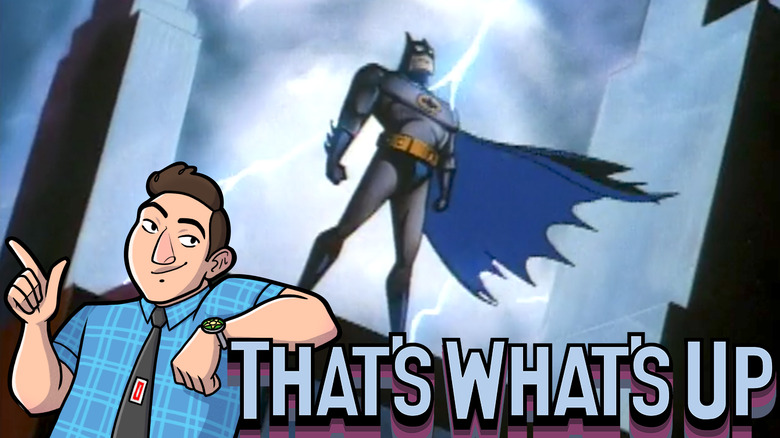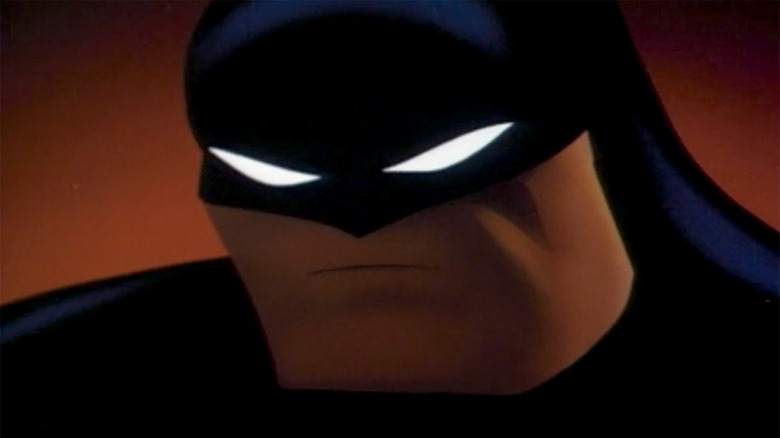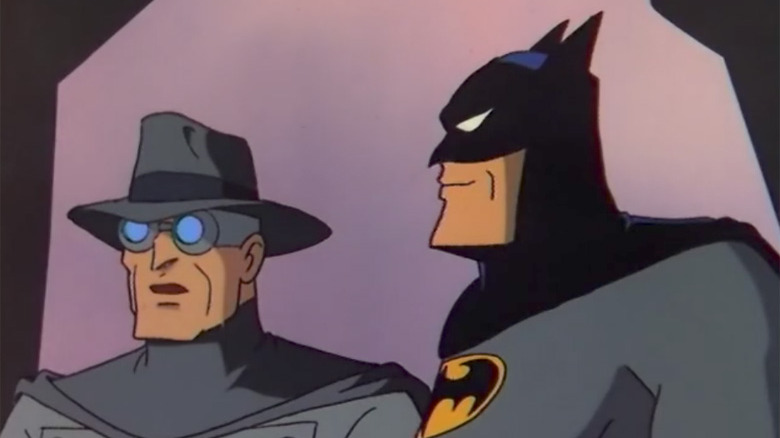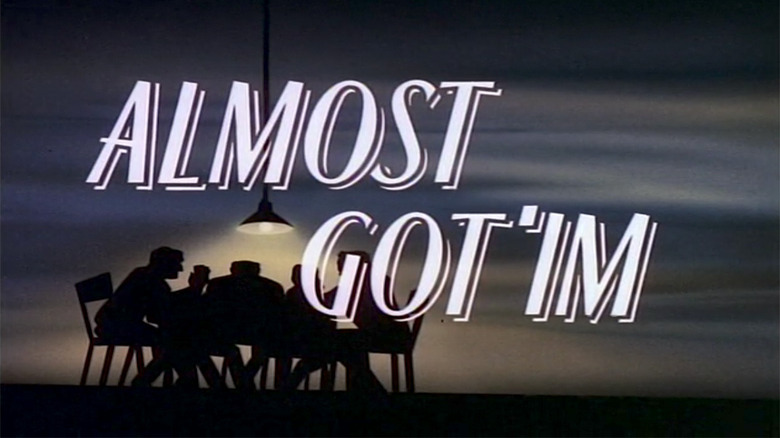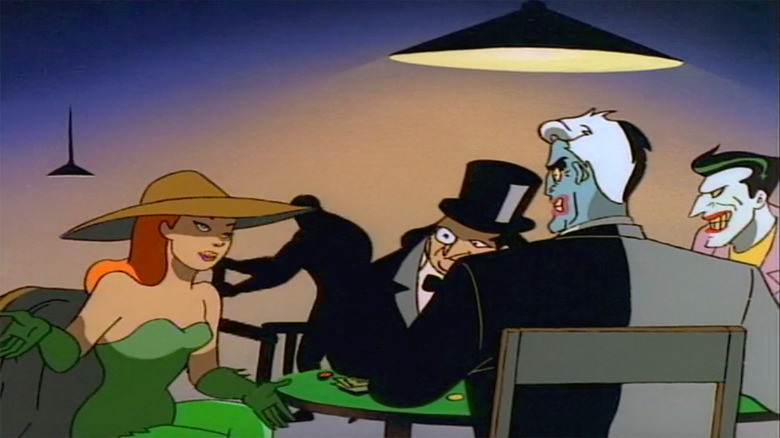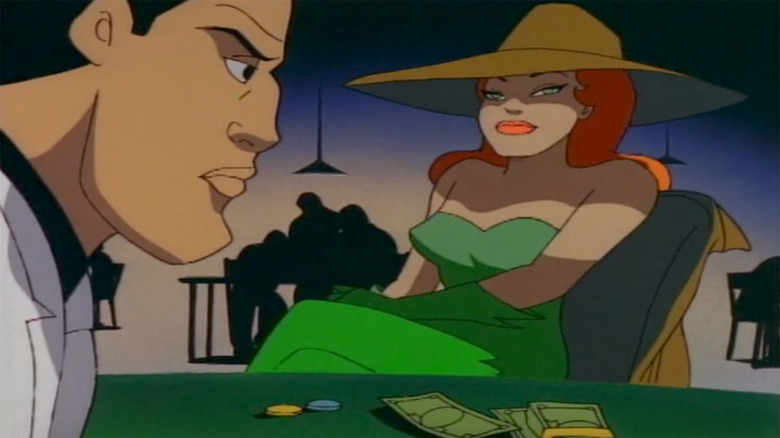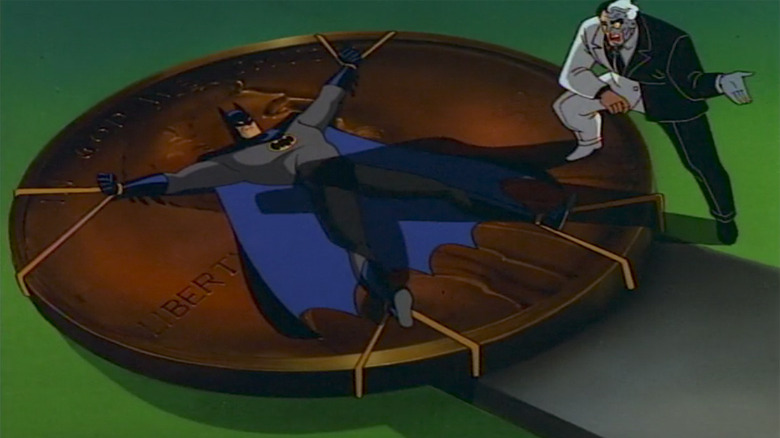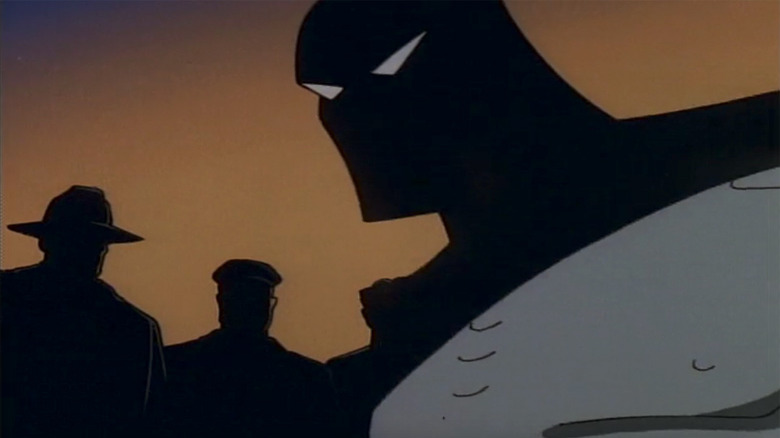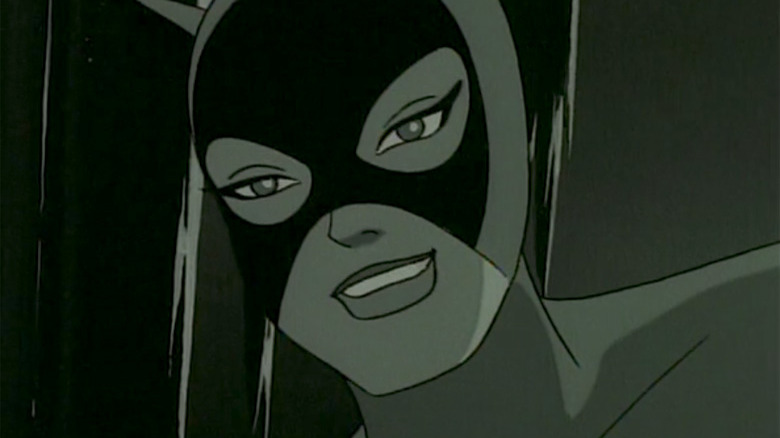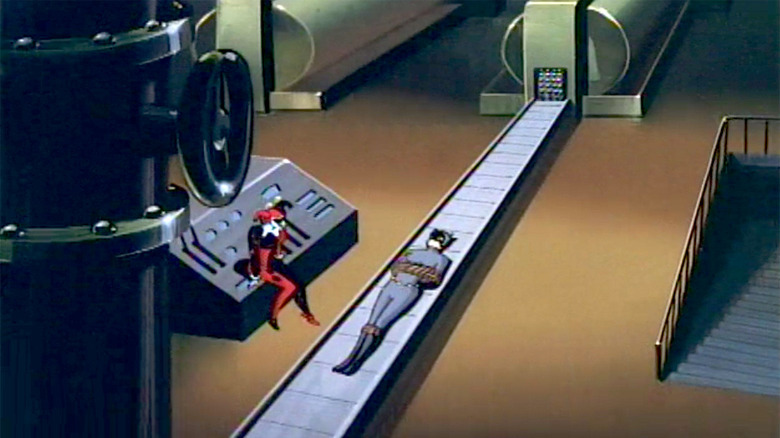That's What's Up: The Perfect Episode Of Batman: The Animated Series
Each week, comic book writer Chris Sims answers the burning questions you have about the world of comics and pop culture: what's up with that? If you'd like to ask Chris a question, please send it to @theisb on Twitter with the hashtag #WhatsUpChris, or email it to staff@looper.com with the subject line "That's What's Up."
Q: It's the 25th anniversary of Batman: The Animated Series. What is not necessarily the best episode, but the one that is a Perfect Unit of Batman? — @charlotteofoz
At first glance, this seemed like one of the toughest questions that I've ever had to answer. I mean, Batman: The Animated Series was genuinely great at a lot of things, but the one thing it did better than anyone else—better than any other version of Batman that we've seen over the past 75 years—was to strip everything about the Dark Knight down to its purest form in a way that somehow never made anything feel like it lacked the complexity that made it work.
You can see it in the characters, of course, but you can also see it in the way everything is designed. Gotham City, for instance, has this beautiful, shadowy art deco aesthetic that connects Batman to his pulpy origins, but it's also a world where supercomputers exist alongside black-and-white TVs and rotary telephones, without ever feeling anachronistic. It all just blends together seamlessly, and the end result is a whole roster of single-episode stories that feel like perfect Batman stories.
Batman: The Animated Series
That makes narrowing down a single one a pretty daunting task. "Joker's Favor" is certainly a favorite, as it nails the terrifying menace of the Joker and how he affects the normal citizens of Gotham City, who are often overlooked as the people truly in danger. By shifting around the focus, putting Batman in the background, it makes the villains we see defeated at the end of every episode seem genuinely threatening. Plus, it's got the first appearance of Harley Quinn, arguably the show's most important contribution to the larger Batman mythos.
Even beyond that, though, there are the stories that were adapted from great comics, like "The Laughing Fish" (inspired by the Steve Englehart and Marshall Rogers story of the same name from Detective Comics #475 – 476), "Appointment In Crime Alley" (Denny O'Neil and Dick Giordano's "There Is No Hope In Crime Alley," from Detective #457), and, my personal favorite, "The Demon's Quest" (O'Neil and Neal Adams's "Daughter of the Demon" from Batman #232). You could make the case for any one of those as a perfect unit of Batman, especially the one that ends with him getting into a shirtless swordfight with an immortal bio-terrorist. That's a big piece of the mythos, and don't let anyone tell you it isn't.
I've even written before about how Eric Radomski and Bruce Timm's opening sequence works as a perfect introduction to the character, silently teaching you every single thing you need to know about Batman in just 57 seconds. You see him fighting criminals that are far beyond the capabilities of the police, you see him not using guns even when his enemies draw theirs first, and you see the level of technology (in the form of a jet-black art deco rocket car) that he employs in his fight against crime.
The best part, though, is the way it uses its visual language to create a hierarchy in Gotham. When the bank robbers escape the police, they do it by going up, climbing to the roof of the building where they'll eventually face Batman—they're literally above the law, beyond the capabilities of the police. The end of the opening sequence, though, with that famous lightning strike that illuminates Batman for the first time, has him placed atop an even higher skyscraper. If the criminals are above the law, then Batman is above them.
That sequence rules pretty hard, is what I'm getting at here.
Beware the Gray Ghost
I'm honestly tempted to make a case for "Beware the Gray Ghost," too, because it's the story that best encapsulates what the idea of Batman means to his readers.
It's a brilliant idea on so many levels. For one, it allows kids who love Batman to identify with their hero by showing him as a kid who loved a superhero, and casting Adam West as your favorite Batman's favorite Batman was a brilliant tribute to the history of the character. It showed that these stories can matter—that they can inspire you to do good. At the same time, by making the villain of the episode another obsessive fan, it shows the darker side to that fandom, too, the person who likes the stuff but never learned the lessons.
Really, though, if you're looking for a single episode that encapsulates everything about Batman, there's only one choice. "Almost Got 'Im."
Almost Got 'Im
Again, this is one that's included at the top of almost every list of the show's best episodes, so in that respect, it actually fulfills both of your questions. For our purposes, though, we need to focus on what it really means to be a "perfect unit of Batman."
Basically, that just means you want a complete story that shows you everything you want to see about Batman—not just the character, but the world in which he lives and the challenges he faces in his life of crimefighting. You want action and adventure, and big set pieces—another thing that BTAS did incredibly well—but you also want to see his relationships with other characters, and the bad guys that make his Rogues Gallery the best roster of supervillains that any hero's ever had.
That's a pretty tall order, cramming in everything there is about Batman without making the story feel bloated and overstuffed, but with "Almost Got 'Im," director Eric Radomski and writer Paul Dini—also the show's Story Editor, who'd write most of the best episodes and go on to write Batman stories in the comics on and off for the next 25 years—pull it off.
Supervillain Poker Night
On a purely functional level, there's just more in this episode than almost any other. The usual approach, and the thing that often made BTAS feel like a more sophisticated cartoon than anything else on TV in the early '90s, was to tell its stories with a slow burn. Moody establishing shots, long sequences without dialogue that let Shirley Walker's fantastic score do the heavy lifting of heightening tension, smooth animation of Batman stalking through the shadows—these are all elements that helped the show feel deliberate without ever seeming slow as it built to its third-act climax.
"Almost Got 'Im" subverts that idea by loading up as much as it can into a single episode. Rather than focusing on a single villain, or even a team-up, it's a story in which four of them cycle through a series of vignettes, cutting straight to the set pieces without sacrificing that moodiness. Batman, for instance, only speaks a few lines in each of the flashbacks, instead working as this silent, omnipresent force that's hanging over the entire proceedings, and helping to underline the big twist in the third act where you find out that he's actually been talking quite a bit. But we'll get back to that in a second.
It's a great use of smaller, shorter high concepts to help the story flow—Poison Ivy attempting to destroy Gotham City with exploding Halloween pumpkins might not have been a strong enough premise to carry a full episode, but a three-minute sequence of Batman battling her in a flaming pumpkin patch works perfectly.
Poison Ivy and Two-Face
Including four major villains—five if you include Catwoman, six if you want to view Harley Quinn and the Joker as two separate forces, and seven if you really want to make the case for counting Killer Croc based on how the other villains treat him—gives the show an opportunity to show how the bad guys interact with each other when Batman's not around. That kind of begrudging camaraderie is a really interesting aspect of what makes those villains work: they all hate Batman, but they hate him in different ways, and they have histories with each other in addition to having histories with him.
Poison Ivy and Two-Face, for instance, are tied together in a way that rarely comes up. In her first appearance, "Pretty Poison," Ivy seduces and attempts to murder Harvey Dent, and it turns out that he still holds a pretty understandable grudge, even after switching sides and becoming a supervillain. There's a history there, and while it's explained well enough that you don't need to know it to enjoy the episode, it establishes another dimension to how they work. They're not just stock adversaries, they're characters in the story, with their own thoughts that exist independently of simply trying to kill Batman, even if that's their most pressing concern.
It's worth noting that there's another episode that aired only a few months after this one that pulled a similar trick. By focusing on the hapless Sid the Squid, "The Man Who Killed Batman" takes viewers on a tour through Gotham City's underworld, interacting with the Joker, who stands in for Batman's more colorful arch-nemeses, and Rupert Thorne, who represents the more "realistic" gangsters. It's one of the best episodes of the show, especially because of the way it treats the Joker's relationship to Batman, but as the title implies, Batman himself is largely absent from it. In "Almost Got 'Im," he's all over the place, in one deathtrap after another.
Heads or tails?
Again, that's a function of having so much going on in a single episode, but you get to see everything Batman can do. He escapes from Poison Ivy's trap with physicality and gadgetry, throwing punches and ramming the Batmobile into a telephone pole. Two-Face's, on the other hand (drawn from World's Finest #30's "The Penny Plunderers, which, in case you were wondering, is the source of the giant penny in the Batcave's trophy room), is escaped with cleverness and stealth. Penguin's story features Batman relying on the Utility Belt and turning his foe's weapons against him, and Joker's finds Batman enduring the pain of an electric chair before escaping.
It's in the frame story, though, that we see Batman at his best. The trick to the episode is, of course, that he's been disguised as Killer Croc the whole time, leading to one of the best visual moments in the entire show: a shadow falling across Croc's face and revealing him to be Batman.
It might not make sense from a realistic perspective, but as a bit of visual shorthand, it's rad as hell.
Even the shadows are theatrical
It's also one of my all-time favorite bits of character work in any version of Batman, ever. The running gag through the whole episode is that the "Killer Croc" who's playing poker with the villains and talking about throwing heavy rocks is actually Batman, pretending to be a dimwit until it's time to throw the Joker through a table. That Batman isn't just sitting quietly at a nearby table disguised as Matches Malone, and that he's instead running a con on his own arch-enemies that involves portraying one of them as a rock-stupid idiot? That's Batman having fun, even in a life-and-death situation, and I love that about this episode.
You don't dress up as a bat and drive around in a rocket car to fight supervillains just because you think a spooky cape is going to give you an edge against crime. Even in Gotham, there are other ways to take a stand. There's a theatricality to Batman, a piece of his character that only really works if you accept that he's a guy who, for all his brooding, truly loves what he does.
It also plays up the idea of Batman as a hero who succeeds by turning the villains' methods against him. Deception and intimidation are tactics usually associated with the bad guys, but Batman uses them for good, terrorizing his enemies with a frightening presence and, in this case, lying to their faces and insulting them in order to gather the information he needs to stop a murder.
Enemies and allies
It's not just the villains who have their relationships defined in this episode, either. It's the allies. Alfred and Robin are absent, of course, but we see Commissioner Gordon and the GCPD, and, more importantly, Catwoman.
When she shows up, she and Batman are unambiguously on the same side, something that immediately sets her apart from the other arch-criminals. They might hate Batman enough to try murdering him with a poisoned hummingbird or whatever, but her relationship with him is far more affectionate, even if they're on opposite sides of the law.
It also establishes a sort of parity between them. Batman rescues her at the end of the episode, but she rescued him first in the Joker's flashback story, putting them on equal footing in terms of heroism.
Old school mustache-twirling villainy
And that plays into the themes of the episode perfectly. While the other crooks tell stories that just involve going up against Batman, the Joker is the one villain of the episode who tries to hurt Batman by killing someone he cares about—and he does it from behind his ever-present smile, insisting that the others tell their stories first because he knows his is far more vicious and the rules of theatricality demand that his be told as the climax.
Even the deathtrap itself reflects that. It's a classic damsel-in-distress cliché, with Catwoman tied on a conveyor belt that's heading towards a quartet of buzzsaw blades. If there was any doubt that Dini and Radomski were hanging a lampshade on it, however, that's eliminated when Harley Quinn offers Batman the equally cliché choice of letting her go or saving Catwoman, not realizing he's within arm's reach of the switch that can shut off the machinery.
This is an episode that knows exactly what it's doing every step of the way, from the broad strokes of the plot and themes all the way down to the little details in the opening: the Penguin drinks tea because he's the villain with delusions of high-class grandeur, Two-Face takes half-and-half in his coffee and takes two cards from the dealer so he can get two pair—two deuces and two face cards. And the Joker? The Joker cheats, of course, but he literally has an ace up his sleeve. We only see Croc's cards for a second, and never in close-up, but it really doesn't matter what he's got in his hand.
He's the one who's bluffing.
Each week, comic book writer Chris Sims answers the burning questions you have about the world of comics and pop culture: what's up with that? If you'd like to ask Chris a question, please send it to @theisb on Twitter with the hashtag #WhatsUpChris, or email it to staff@looper.com with the subject line "That's What's Up."
